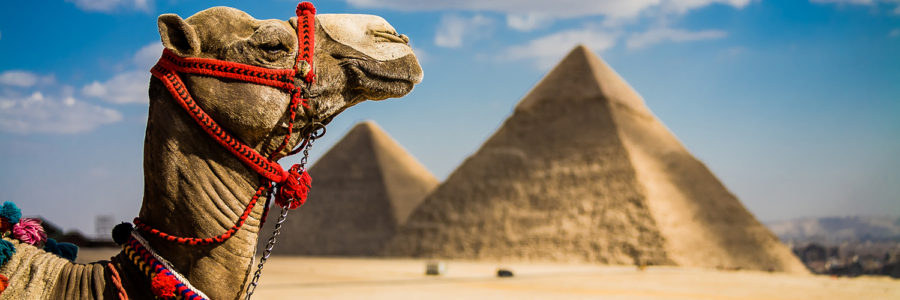
About The Nile River
The Ancient Egyptians called the Nile Ḥ’pī or Iteru (Happy), meaning “river.”
4,258 miles in length, flowing north from the mountains of the African Gorge to a sprawling delta spilling into the Mediterranean, the Nile is one of the longest rivers in the world. In all, it flows through 11 countries: Egypt, the Republic of Sudan, South Sudan, Ethiopia, Uganda, the Democratic Republic of the Congo, Kenya, Tanzania, Eritrea, Burundi, and Rwanda.
The lifeline of civilization since the Stone Age, the Greek historian Herodotus wrote that “Egypt was the gift of the Nile.” The source of the country’s great agricultural wealth, the river was also an important part of Egyptian spiritual life, with nearly all the great cultural and historical sites of Ancient Egypt built along its riverbanks.
Given the vast distances that lie between destinations, river cruising is the best way to pack it all in. In the hands of expert guides, you’ll visit legendary sites like Abu Simbel, Luxor, the Valley of the Kings, and, of course, the Mother of Cities, Cairo, and the adjacent Great Pyramids. Traveling back in time as you journey in true Egyptian style and luxury, there’s simply no better way to immerse yourself in the treasures of the Nile.
Nile River Stats
Length: 4,258 miles
Depth: Average 26 to 36 feet
Source: White Nile, Rwanda & Blue Nile, Ethiopia
Mouth: Mediterranean Sea near Alexandria, Egypt
Locks: 3
Countries: Egypt | Sudan | South Sudan | Ethiopia | Uganda | Congo | Kenya | Tanzania | Rwanda | Burundi | Eritrea
More about the Nile River of Africa
The Nile River, often referred to as the “gift of Egypt,” is one of the world’s most iconic and historically significant waterways. Stretching over 4,100 miles, it is not only the longest river in the world but also a cradle of civilization, a vital source of sustenance, and a testament to the profound influence that rivers can have on the development of human societies and ecosystems. In this exploration of the Nile River, we will delve into its geography, history, cultural significance, ecological importance, and the challenges it faces in the modern world.
Geography and Hydrology
The Nile River flows northward through northeastern Africa, originating from two main tributaries: the White Nile, which begins at Lake Victoria in Uganda, and the Blue Nile, which starts at Lake Tana in Ethiopia. These two tributaries merge in Sudan to form the Nile proper, which then flows through Egypt and eventually empties into the Mediterranean Sea. The Nile’s unique geography has played a crucial role in shaping the region’s landscape. Its annual flooding, known as the inundation, deposits nutrient-rich silt onto the adjacent floodplains, creating fertile soil that has enabled agriculture to flourish for millennia. This cyclical inundation was so predictable that it became the basis for the ancient Egyptian calendar.
Historical Significance
The Nile River holds a central place in the history of human civilization. It was along the fertile banks of the Nile that one of the world’s earliest and most enduring civilizations, ancient Egypt, emerged. The Nile Valley was home to the Pharaohs, and its waters sustained the growth of this magnificent civilization for thousands of years. Egypt’s agricultural success was deeply intertwined with the Nile’s annual floods. Farmers relied on the inundation to replenish the soil and ensure bountiful harvests. The Nile also served as a vital transportation route, facilitating trade and cultural exchange between Egypt and other ancient civilizations in Africa, the Mediterranean, and the Middle East. The Nile’s historical significance extends beyond Egypt. It played a critical role in the emergence of Nubian kingdoms in what is now Sudan, and it shaped the destinies of African societies along its course, contributing to the development of cultures and kingdoms in Ethiopia and Uganda.
Cultural Significance
The Nile River has been celebrated in literature, art, and religion for millennia. In ancient Egyptian mythology, it was personified as the god Hapi, symbolizing the river’s life-giving properties. The Nile also features prominently in the biblical narrative, particularly in the story of Moses and the Exodus. Throughout history, poets, writers, and explorers have been captivated by the Nile’s beauty and mystique. It inspired famous authors like Agatha Christie, who set her novel “Death on the Nile” along its banks. The river’s enduring allure continues to draw tourists from around the world, who come to witness its breathtaking scenery and explore the remnants of ancient civilizations.
Ecological Importance
The Nile River basin is home to a diverse range of wildlife, including various fish species, birds, and mammals. The river supports the survival of many species, including the Nile crocodile, which is native to the region. The wetlands and floodplains adjacent to the Nile provide essential breeding grounds for countless species of birds, contributing to the global biodiversity of the region. However, the Nile’s ecology faces numerous challenges in the modern era. Population growth, urbanization, and agricultural expansion have placed enormous pressure on the river’s resources. Over-extraction of water for irrigation and industrial use, pollution from urban areas, and habitat destruction all threaten the fragile ecosystems of the Nile and its tributaries.
Modern Challenges
The Nile River has been a source of contention among the countries sharing its waters. The Nile Basin includes 11 countries, with Egypt and Sudan historically holding significant control over its waters due to colonial-era agreements. However, upstream countries like Ethiopia have sought to assert their rights to use the Nile’s waters for development, leading to diplomatic tensions and negotiations over water-sharing agreements. Climate change presents another formidable challenge to the Nile River. Variability in rainfall patterns, increasing temperatures, and the potential for more severe droughts can disrupt the delicate balance of the river’s ecosystem and exacerbate existing water stress issues.
